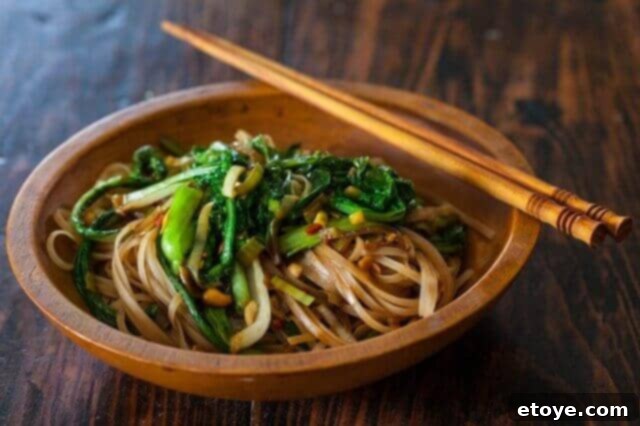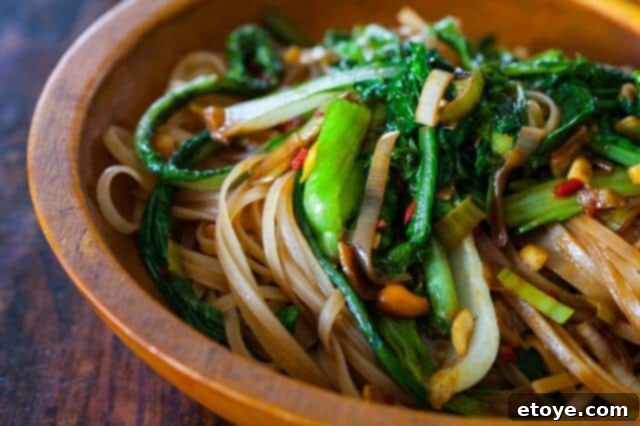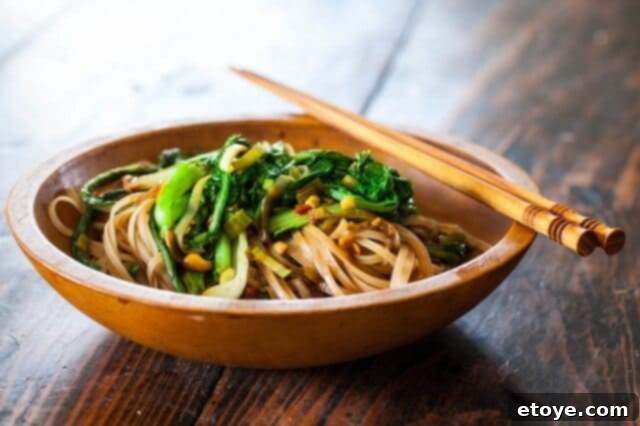Unlock a world of vibrant flavors with our irresistible Vegetarian Satay Noodles and Greens recipe! This dish brilliantly captures all the savory, nutty essence of traditional meat satay, transforming it into a hearty, plant-based meal that’s both deeply satisfying and incredibly easy to prepare. Inspired by the insightful nutritional principles from Dale Pinnock’s acclaimed cookbook, The Medicinal Chef, this recipe isn’t just about taste; it’s about nourishing your body with every delicious bite. Prepare to tantalize your taste buds and discover your new go-to weeknight favorite!

Why Our Vegetarian Satay Noodles Are a Must-Try
There’s a reason this Satay Noodles and Greens recipe stands out. It combines the exotic allure of Southeast Asian cuisine with the convenience of a quick, healthy home-cooked meal. Here’s what makes this dish truly special:
- An Irresistibly Addictive Flavor Profile: The star of the show is undeniably the rich, creamy, and slightly spicy peanut satay sauce. It coats every noodle and piece of green, creating a symphony of sweet, savory, and umami notes that will have you craving more.
- Expertly Crafted by Chef Dale Pinnock: This recipe draws inspiration from The Medicinal Chef, a cookbook renowned for its focus on healthful eating without compromising on flavor. Chef Pinnock’s philosophy of food as medicine shines through, making this dish both delicious and beneficial for your well-being.
- Ready in Just 20 Minutes: From the moment you start prepping to the first forkful, this meal comes together in under half an hour. It’s the perfect solution for busy weeknights when you want something flavorful and homemade, but don’t have hours to spend in the kitchen.
- Versatile & Customizable: While designed as a vegetarian delight, this recipe is incredibly adaptable. Easily incorporate your favorite proteins or a wider array of vegetables to suit your pantry and preferences.
- Packed with Nutrients: Loaded with fresh greens and wholesome rice noodles, this dish is a fantastic source of vitamins, minerals, and plant-based protein, contributing to a balanced and energetic lifestyle.
Essential Ingredients for Your Satay Noodles
Crafting these amazing Satay Noodles requires a simple list of readily available ingredients. The beauty of this recipe lies in its ability to transform everyday pantry staples into a gourmet experience. Here’s what you’ll need to gather:
- Dry rice noodles
- Cooking oil (such as vegetable or canola)
- Fresh leek
- Garlic cloves
- Chili pepper (green or red)
- Shredded greens (e.g., cabbage, napa cabbage, bok choy, tatsoi)
- Hot water
- Chunky peanut butter
- Dark soy sauce
- Honey
- Chinese Five Spice powder
- Kosher salt or sea salt
This carefully selected list ensures a balanced and authentic flavor without being overly complicated. Each component plays a crucial role in building the dish’s complexity and nutritional value.
Crafting Your Delicious Satay Noodles – A Step-by-Step Guide
Making these vegetarian satay noodles is a straightforward process, designed for efficiency without sacrificing flavor. Follow these simple steps to bring this delightful dish to your table:
- **Prepare the Noodles and Sauce:** Begin by soaking the dry rice noodles in warm water for 5-8 minutes until they are pliable but still firm. While the noodles soak, prepare your flavorful satay sauce. In a medium bowl, whisk together the hot water, chunky peanut butter, dark soy sauce, honey, Chinese five-spice powder, and kosher salt. Stir until smooth and well combined, then set this aromatic sauce aside.
- **Process the Leek:** Next, prepare the leek. For this recipe, we’ll primarily use the white and light green parts. Thoroughly wash the leek, separating its layers slightly under running water to remove any hidden dirt or grit. Once clean, slice the leek very thinly, as these delicate pieces will quickly soften and release their mild, sweet onion-like flavor into the stir-fry.
- **Sauté Aromatics:** Heat the cooking oil in a large sauté pan or a wok over medium heat until it just begins to shimmer. Add the thinly sliced leek, minced garlic cloves, and chili pepper to the hot oil. Sauté for approximately 2 minutes, stirring frequently. Be mindful not to burn the garlic, as this can lead to a bitter taste. The goal is to soften the leeks and release the fragrant aromas of garlic and chili.
- **Incorporate the Greens and Sauce:** Add the shredded greens to the pan. Continue to cook for about 1 minute, or until the greens have slightly softened and brightened in color. Increase the heat to medium-high, then pour in the reserved peanut satay sauce mixture, ensuring it coats all the vegetables. Bring the sauce to a gentle simmer.
- **Finish with Noodles:** Once the sauce begins to bubble slightly, drain the softened rice noodles thoroughly and add them directly to the pan. Toss everything together, ensuring the noodles are evenly coated with the rich satay sauce. Cook for an additional 1-2 minutes, stirring constantly, until the noodles are fully cooked through and have absorbed some of the sauce’s wonderful flavor. Serve immediately and enjoy!

Understanding Satay: A Culinary Journey
To truly appreciate this vegetarian rendition, it’s helpful to understand the origins of satay. Satay is a beloved grilled meat dish, synonymous with the vibrant street food culture found throughout Southeast Asia. While often associated with Thailand or Malaysia, Indonesia is widely considered its birthplace. From there, this flavorful culinary tradition spread across the region, becoming a staple in countries like Singapore, the Philippines, and beyond.
Traditionally, satay features skewered and grilled pieces of meat, most commonly chicken or pork, though beef and even goat are popular variations. These succulent skewers are typically served with a rich, aromatic peanut sauce – the hallmark of satay. Our recipe ingeniously captures this iconic peanut sauce, combining its distinctive savory, sweet, and nutty profile with wholesome noodles and fresh greens. By doing so, we’ve created a deeply flavorful and satisfying vegetarian dish that honors the essence of satay while being entirely plant-based. It’s proof that you don’t need meat to enjoy the robust and comforting flavors of this Southeast Asian classic!
The Ultimate Easy Vegetarian Weeknight Meal
Searching for a meal that’s quick, healthy, and incredibly flavorful? Our Satay Noodles and Greens are the perfect answer. This dish embodies everything you’d want in an easy vegetarian weeknight meal. Imagine fresh, crisp greens, perhaps even plucked from your own garden, combined with versatile Asian dried rice noodles and a ridiculously simple, stir-together sauce. It’s a complete meal that transitions from your pantry to your dinner table in just 20 minutes!
The beauty of this recipe lies in its sheer convenience and adaptability. If chunky peanut butter, soy sauce, and a few basic Asian pantry essentials are staples in your home, you likely have most of what you need to whip up these Satay Noodles right now. Much like other stir-fries, this dish celebrates flexibility. There are no rigid rules about what vegetables or even proteins you can incorporate. Feel free to use what’s already in your fridge – whether it’s leftover broccoli, bell peppers, or even some edamame – rather than making a special trip to the grocery store. This makes it a fantastic recipe for minimizing food waste and maximizing flavor with minimal effort.

Enhance Your Satay Noodle Experience: Delicious Add-Ins
While our Satay Noodles and Greens recipe is wonderfully hearty and delicious as a vegetarian main, it also serves as an excellent canvas for customization. If you’re looking to add extra layers of flavor, texture, or protein, don’t hesitate to experiment! Here are some fantastic ideas to elevate your dish:
- Protein Power-Ups:
- Chicken: Sliced chicken breast or thigh, cooked and added at the end.
- Beef: Thinly sliced sirloin or flank steak, stir-fried until tender.
- Tofu: Cubed and pan-fried or baked tofu adds plant-based protein and a wonderful chewy texture.
- Shrimp: Quick-cooking shrimp can be tossed in during the last few minutes.
- Vibrant Vegetables:
- Broccoli florets: Add a pleasant crunch and vibrant green color.
- Bell peppers: Sliced red, yellow, or orange bell peppers contribute sweetness and a beautiful visual appeal.
- Mushrooms: Sliced shiitake or cremini mushrooms add an earthy, umami depth.
- Carrots: Julienne carrots for extra color and a hint of sweetness.
- Snow peas or snap peas: Provide a fresh, crisp element.
- Fresh Herb Finishers:
- Cilantro: A generous sprinkle of fresh cilantro offers a bright, citrusy counterpoint to the rich sauce.
- Mint: Chopped fresh mint can add an unexpected and refreshing zing.
- Extra Crunch & Flavor:
- Crushed peanuts: For an extra layer of nutty texture.
- Toasted sesame seeds: Add a subtle nutty aroma and visual appeal.
- Lime wedges: A squeeze of fresh lime juice brightens the entire dish.
Don’t be afraid to get creative and make this recipe truly your own. The versatility of satay noodles means there’s always room to explore new flavor combinations!

Top Tips for Perfect Satay Noodles Every Time
Achieving perfectly cooked, flavorful Satay Noodles is easy with a few insider tips. Keep these pointers in mind for a seamless cooking experience and a dish that truly shines:
- Wok vs. Wide-Bottomed Pan: While a traditional wok is ideal for stir-frying due to its even heat distribution and large surface area, don’t worry if you don’t have one. A wide-bottomed sauté pan or a large skillet will work just as well. The key is to have enough space for all your ingredients to cook evenly without overcrowding.
- The Art of Mise en Place: Stir-fries come together very quickly, so preparation is paramount. Ensure all your ingredients are prepped, chopped, and measured before you even turn on the heat. This includes soaking your noodles, slicing your leeks and garlic, mincing your chili, and whisking your sauce. Having everything ready means you can focus on the cooking process without interruption, preventing anything from burning.
- Customize Your Protein: This recipe is designed to be a delicious vegetarian main, but it’s incredibly versatile. Feel free to add cooked chicken, beef, shrimp, or extra tofu for a heartier meal. Simply add pre-cooked proteins at the very end, or cook raw proteins first, set them aside, and reintroduce them with the sauce.
- Thorough Leek Washing is Key: Leeks are notorious for trapping dirt and grit between their many layers. To ensure a clean dish, wash your leek very well. After slicing, separate the rings or half-moons slightly and rinse them thoroughly under cold running water. This crucial step prevents any unpleasant grittiness in your final dish.
- Don’t Overcook the Noodles: Rice noodles cook quickly. Pay close attention during the final step to ensure they are cooked through but still have a pleasant bite (al dente). Overcooked noodles can become mushy and less enjoyable.
- Adjust Spice to Your Liking: The amount of chili pepper can be adjusted to your personal spice preference. Use less for a mild dish, or more for a fiery kick!

Watch the Magic Unfold: Satay Noodles and Greens Recipe Video
Sometimes, seeing is believing! For those who prefer a visual guide, we’ve included a helpful video demonstration to walk you through each step of preparing these fantastic Satay Noodles and Greens. Watch as the ingredients come together, and get a clear understanding of the techniques involved to ensure your dish is perfect.
Explore More Delicious Satay Creations
If you’ve fallen in love with the flavors of satay, there’s a whole world of dishes waiting to be explored! From classic meat skewers to other innovative noodle creations, satay-inspired cuisine is always a crowd-pleaser. Here are a few other delectable satay dishes you might enjoy:
- Chicken Satay with Peanut Noodles
- Beef Satay Skewers with Habanero Peanut Sauce
- Hainanese Chicken Rice Recipe
- Classic Chicken Satay
Satay Noodles and Greens Recipe Card
Yields: 4 servings
Prep time: 10 minutes
Cook time: 10 minutes
Total time: 20 minutes
Author: Jaden Hair
Course: Main Course
Cuisine: Asian
Keywords: peanut noodles, satay recipe, vegetarian noodles
Ingredients:
- 8 ounces dry rice noodles
- 1 tablespoon cooking oil
- 1 large leek, white and light green parts only, very thinly sliced
- 2 garlic cloves, thinly sliced
- 1 small green or red chili pepper, minced (adjust to taste)
- 4 handfuls shredded greens (such as cabbage, napa cabbage, bok choy, or tatsoi)
- 2 tablespoons hot water
- 4 tablespoons chunky peanut butter
- 2 tablespoons dark soy sauce (or 2 tablespoons regular soy sauce + 1 tablespoon brown sugar)
- 1 tablespoon honey
- 1 teaspoon Chinese five-spice powder
- 1/2 teaspoon sea or kosher salt
Instructions:
- Soak the dry rice noodles in warm water for 5-8 minutes, or until pliable. In a bowl, whisk together the hot water, peanut butter, dark soy sauce, honey, five-spice powder, and salt. Set aside.
- Thoroughly wash the leek, separating layers to remove any dirt, then slice very thinly.
- Heat the cooking oil in a large sauté pan or wok over medium heat until shimmering. Add the sliced leek, garlic, and chili pepper. Cook for 2 minutes, being careful not to burn the garlic.
- Add the shredded greens to the pan and continue to cook for about 1 minute until slightly softened.
- Turn the heat to medium-high and pour in the whisked peanut sauce mixture. Bring to a gentle bubble.
- Drain the rice noodles. Add them to the bubbling sauce and cook for 1-2 minutes, tossing continuously, until the noodles are fully cooked and coated with the sauce. Serve immediately.
Nutrition (per serving):
- Calories: 411 kcal
- Carbohydrates: 69g
- Protein: 7g
- Fat: 12g
- Saturated Fat: 2g
- Sodium: 639mg
- Potassium: 241mg
- Fiber: 3g
- Sugar: 14g
- Vitamin A: 495 IU
- Vitamin C: 26 mg
- Calcium: 46 mg
- Iron: 2 mg
Have you tried this Satay Noodles recipe? We’d love to hear about your experience! Feel free to leave a star rating and share your thoughts in the comments below. Your feedback helps us and other home cooks discover new favorites!
Legend image reprinted with permission from The Medicinal Chef © 2013 Dale Pinnock, Sterling Publishing Inc. Co. Photography by Martin Poole.
If there’s one cookbook to consider adding to your collection, The Medicinal Chef by Dale Pinnock is highly recommended. Dale’s core philosophy centers on the idea that food should go beyond merely satisfying hunger; it should actively contribute to healing and enhancing your body’s overall health. Each recipe within the book is thoughtfully accompanied by a concise chart, highlighting specific ailments or health aspects that the included ingredients can positively impact.
In the context of our Satay Noodles and Greens recipe, with its rich and flavorful peanut sauce, the ingredients are particularly beneficial for:

This commitment to well-being makes every meal not just a culinary pleasure but also a step towards better health.
